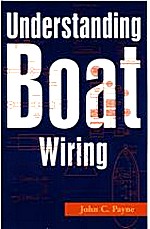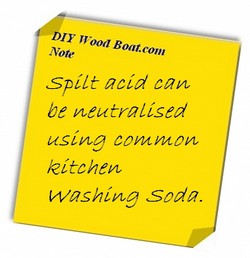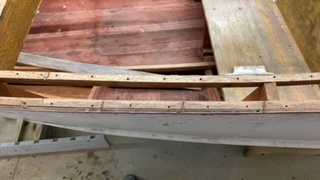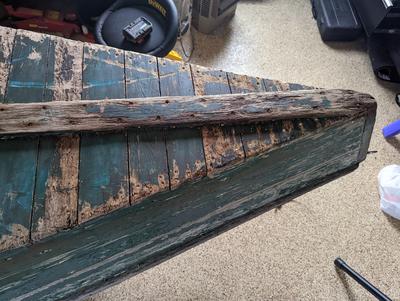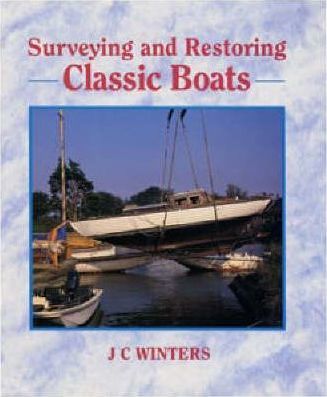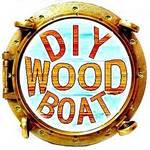Anodes for Wooden Boats
We are all aware that sacrificial 'zincs' are necessary for the protection of the metal in those critical boat and motor components.
However, while the basic principles of electrolytic corrosion are relatively simple they tend to become more complicated when applied to Wooden Boats.
Other Ways to Reduce Galvanic Corrosion.
As well as fitting the correct
'zincs' there are a number of precautions you can take to reduce the
effects of galvanic corrosion.
The electrolytic action between different metals parts is conducted through the water connecting them.
So, the better they are insulated from the water the less likely they are to inter-connect.
The paint on your boat's hull is the first important barrier against corrosion.
Though there are some paints to be wary of using.
Copper based anti-fouling for instance should not be applied directly to bare metal surfaces, use the correct undercoat first.
And Zinc metal sprays are not recommended for use below the water line.
But of course, never paint them.
Stray current leakage can be reduced by making sure that the electrics on board are installed correctly.
Use only high grade insulated wiring of suitable capacity and corrosion resistant terminals.
Make sure all wires are protected and supported prevent fatigue.
Fit an isolation switch in the battery circuit and fit fuses to all circuits.
Above all keep all wiring out of the bilges.
If you fit new electrical or electronic equipment check that the polarity of connections is correct.
Better still, do away with some of those bits of electrical gadgetry.
If your boat lives in a marina, never leave her plugged in to the shore power.
However, that won't protect you from voltage leaking from other boats tied up nearby.
So, don't forget the 'zincs' but on a wooden boat don't over do them.
What Type for Your Boat?
First I'd like to make a mention of those Internal-anodes, which are often overlooked.
These are the ones that protect mechanical components such as raw water cooled engines and heat exchangers.
Usually they screw into the water-jacketing and need to be replaced at specified intervals.
Stern drives and outboard motors, because they are usually made of aluminium require aluminium anodes rather than zinc.
For exterior hull protection there are three main types of Anode material.
It is best to fit protection to suit the waters in which you normally moor your boat.
Zinc is the most common type, because it is the simplest and cheapest material available that would do the job.
However when used in freshwater, zinc forms a coating of zinc hydroxide that insulates it and stops it from working.
The Magnesium anodes are often used in freshwater but tend to disappear very quickly when used in saltwater and wooden boats can be overprotected by very active magnesium.
A recent innovation is an alloy of aluminium, zinc and indium which I am told lasts longer and provides better protection.
However, Zinc still remains the most commonly used on wooden boats.
affiliate linksHow Many Anodes and Where to Fit them.
It is a natural to assume that the more one has the better the protection.
Unfortunately, this is not necessarily true for wooden boats.
In fact an excess of them can be the cause of extensive decay to the timber surrounding the anode and the metal it was supposed to protect.
And as most manufacturers' instructions are aimed at the plastic boat market these can sometimes be misleading.
I wish I could give you some hard and fast rules, unfortunately it all depends on your boat, the metals which are used on her, how these interact and the amount of stay current in and around her.
It could be a fitting secured with fastenings of a different metal or an iron ballast keel close to the plank fastenings.
For instance bronze being one of the more noble metals is a favorite with wooden boaters and because it is so noble it is considered reasonable not to bond bronze through hull fittings to the galvanic corrosion system.
However, if your prop shaft is a more noble stainless steel, the less-noble bronze will be the one to corrode away.
This will happen wherever two very dissimilar metals are either in direct contact with one another or connected by the water.
However, on wooden boats the main area of concern is principally the stern gear, propellers, shafts, shaft brackets, stern tubes, rudders and keels.
Not only are these expensive to replace but they are vital to the safe boating.
And the 'zinc' must be in direct contact with metal it is there to protect in order to be effective.
So, if your propeller and shaft are of dissimilar metals, e.g. a bronze prop and stainless shaft, then you should fit a shaft anode, one for each shaft.
For the same reason on a metal rudder it should be bolted directly to the rudder.
There are plenty of wooden boat owners who are happy not to use any zincs.
They feel that their boats have a minimum of dissimilar metals, the water contact between them is not a problem and they are not concerned about stray current.
Personally I feel happier having at least one main one located on hull just below the turn of the bilge.
Whatever you decide is right for your boat there are some dos and don'ts,
- The anode must be electrically connected to the metal it's protecting.
- Any bonding cable should be as short as possible.
- Internal fixing bolts should be above the bilge line and where they can be accessed easily.
- Use plenty of silicon sealant around the fastenings this will not only reduce leaks but help reduce wood decay and corrosion.
- Site them where they won't interfere with the flow across log impellers or depth transducers.
- If there are mild steel bilge keels they should have separate zincs affixed.
- Use a convenient bolt on the engine block to bond to one of the fixing studs.
- Use bonding wire which has a low electrical resistance and is resistant to corrosion.
And remember, checking your zincs should be part of her annual check-up.
Replace them before they have eroded completely away.
NATIVE ASYNC
Previous posts
See What Others Have Posted
Electrical on a wooden boat?
Where do you place an anode on the outer hull of a wooden boat?
OR Is the anodes on the outboard or outdrive enough?
Should there be a ground strip …
Shaft Anode onWwooden Boat
Is it mandatory to fit shaft anode on wooden boat with copper cladding?
